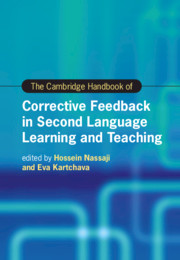Book contents
- The Cambridge Handbook of Corrective Feedback in Second Language Learning and Teaching
- Cambridge Handbooks in Language and Linguistics
- The Cambridge Handbook of Corrective Feedback in Second Language Learning and Teaching
- Copyright page
- Contents
- Figures
- Tables
- Contributors
- Acknowledgments
- Introduction Corrective Feedback in Second Language Teaching and Learning
- Part I Theoretical Perspectives on Corrective Feedback
- Part II Methodological Approaches in the Study of Corrective Feedback
- 5 Tools to Measure the Effectiveness of Feedback
- 6 Laboratory-Based Oral Corrective Feedback
- 7 Classroom-Based Research in Corrective Feedback
- 8 Meta-Analysis and Research Synthesis
- Part III Different Delivery Modes of Corrective Feedback
- Part IV Feedback Provider, Feedback Intensity, and Feedback Timing
- Part V Corrective Feedback and Language Skills
- Part VI Contexts of Corrective Feedback and Their Effects
- Part VII Learners’ and Teachers’ Feedback Perspectives, Perceptions, and Preferences
- Part VIII Individual Differences, Tasks, and Other Language- and Learner-Related Factors
- Index
- References
7 - Classroom-Based Research in Corrective Feedback
from Part II - Methodological Approaches in the Study of Corrective Feedback
Published online by Cambridge University Press: 26 February 2021
- The Cambridge Handbook of Corrective Feedback in Second Language Learning and Teaching
- Cambridge Handbooks in Language and Linguistics
- The Cambridge Handbook of Corrective Feedback in Second Language Learning and Teaching
- Copyright page
- Contents
- Figures
- Tables
- Contributors
- Acknowledgments
- Introduction Corrective Feedback in Second Language Teaching and Learning
- Part I Theoretical Perspectives on Corrective Feedback
- Part II Methodological Approaches in the Study of Corrective Feedback
- 5 Tools to Measure the Effectiveness of Feedback
- 6 Laboratory-Based Oral Corrective Feedback
- 7 Classroom-Based Research in Corrective Feedback
- 8 Meta-Analysis and Research Synthesis
- Part III Different Delivery Modes of Corrective Feedback
- Part IV Feedback Provider, Feedback Intensity, and Feedback Timing
- Part V Corrective Feedback and Language Skills
- Part VI Contexts of Corrective Feedback and Their Effects
- Part VII Learners’ and Teachers’ Feedback Perspectives, Perceptions, and Preferences
- Part VIII Individual Differences, Tasks, and Other Language- and Learner-Related Factors
- Index
- References
Summary
Classroom-based research concerned with corrective feedback plays a critical role in our understanding of how contextual factors shape teaching and learning, as well as our understanding of research. This chapter draws on descriptive and experimental studies investigating corrective feedback in the classroom to examine the role of context and the ways in which contextual factors have been considered, and at times neglected, in research. It highlights how both macro and micro dimensions of classroom contexts have had an impact on the ways in which researchers design, carry out, and interpret their work and teachers might draw on findings for classroom practice. Discussion explores how classrooms have and will continue to change, making a consideration of context imperative beyond a variable to be accounted for in research. The chapter suggests that the diversity of classroom contexts be leveraged to enrich the research
Keywords
- Type
- Chapter
- Information
- The Cambridge Handbook of Corrective Feedback in Second Language Learning and Teaching , pp. 147 - 163Publisher: Cambridge University PressPrint publication year: 2021
References
- 1
- Cited by

